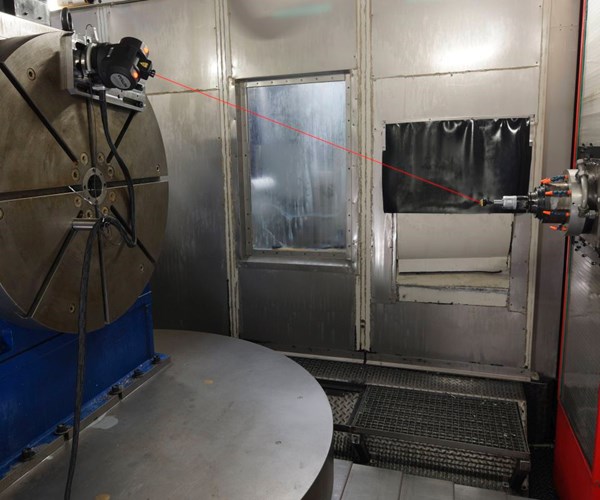With Larger Parts, Larger Need for Volumetric Compensation
To optimize the production of large, high-precision parts, it is important to capture a machine tool’s volumetric deviations and then compensate for them.
Share






This example shows rotation-axis calibration of a large machine tool with axis travels measuring 2.5 by 2.3 by 0.8 m3. The LaserTracer-NG, which is mounted on a rotary table with a diameter of 1.2 meters, is positioned stationary in the machine several times.
Oftentimes, when manufacturers produce smaller-sized parts with wide manufacturing tolerances, the overall geometric accuracy of the machine tools won’t prevent those parts from being machined to specification. However, for shops that produce small batches (think one to two parts) of large, precision parts made from expensive materials, a machine’s accuracy within its entire available workzone becomes crucial. The accuracy becomes tough to maintain though, because large parts require cutting in the far corners of the workzone. This is where volumetric compensation—a way of capturing and compensating for possible distortions to a machine’s structure—comes into play.
In this case study, Präwest Präzisionswerkstatten of Germany uses six-axis milling machines with parallel axes to machine dimensionally accurate parts that measure longer than 2 meters while meeting accuracy tolerances of ±0.05 mm (±0.002 inch) in six axes of movement. To do this, the company captures its machine tools’ volumetric deviations with the LaserTracer-NG, a self-tracking laser interferometer from Etalon AG (which has a in Kirkland, Washington) and compensates them through the KinematicsComp software option in Heidenhain Corp.’s machine controls. Using this method, the company can provide dimensionally accurate workpieces without any readjustments. Read the case study to learn how.
Related Content
-
Ballbar Testing Benefits Low-Volume Manufacturing
Thanks to ballbar testing with a Renishaw QC20-W, the Autodesk Technology Centers now have more confidence in their machine tools.
-
6 Machine Shop Essentials to Stay Competitive
If you want to streamline production and be competitive in the industry, you will need far more than a standard three-axis CNC mill or two-axis CNC lathe and a few measuring tools.
-
Using Digital Tap Testing to Measure Machining Dynamics
Tool-toolholder-spindle-machine combinations each have a unique vibration response. We can measure the response by tap testing, but we can also model it.













